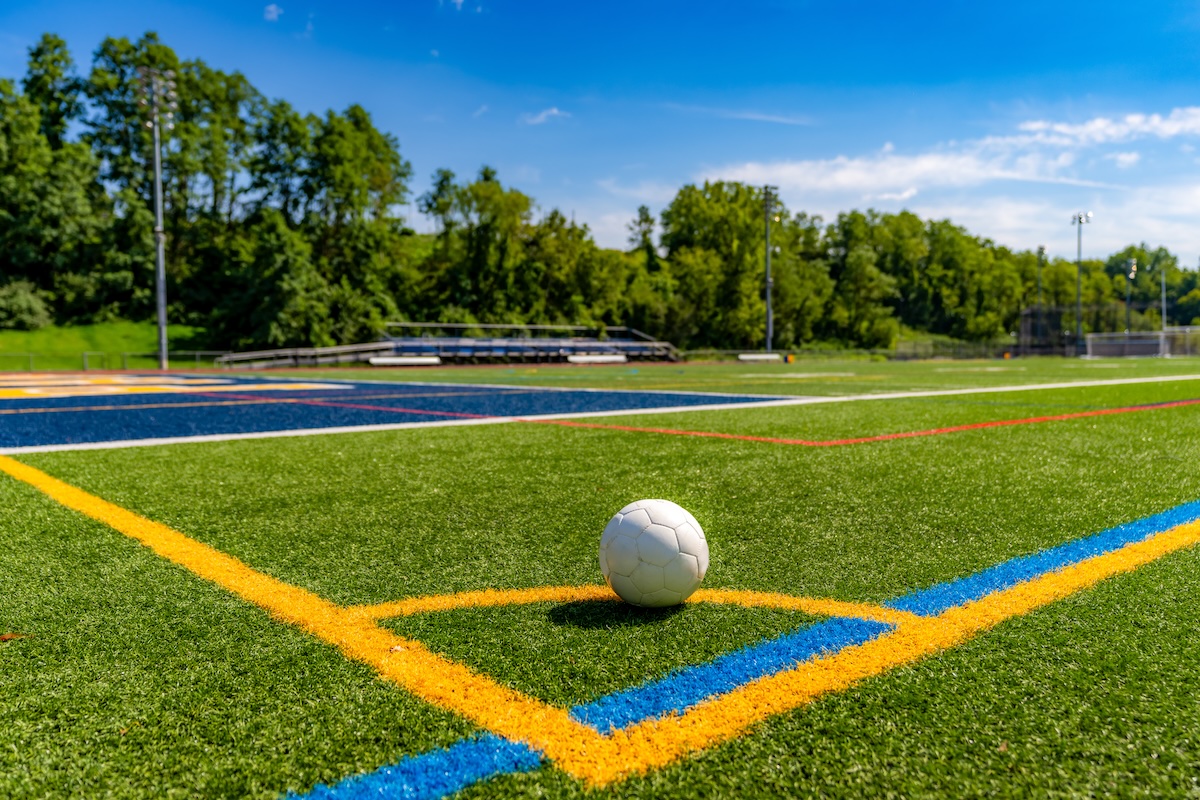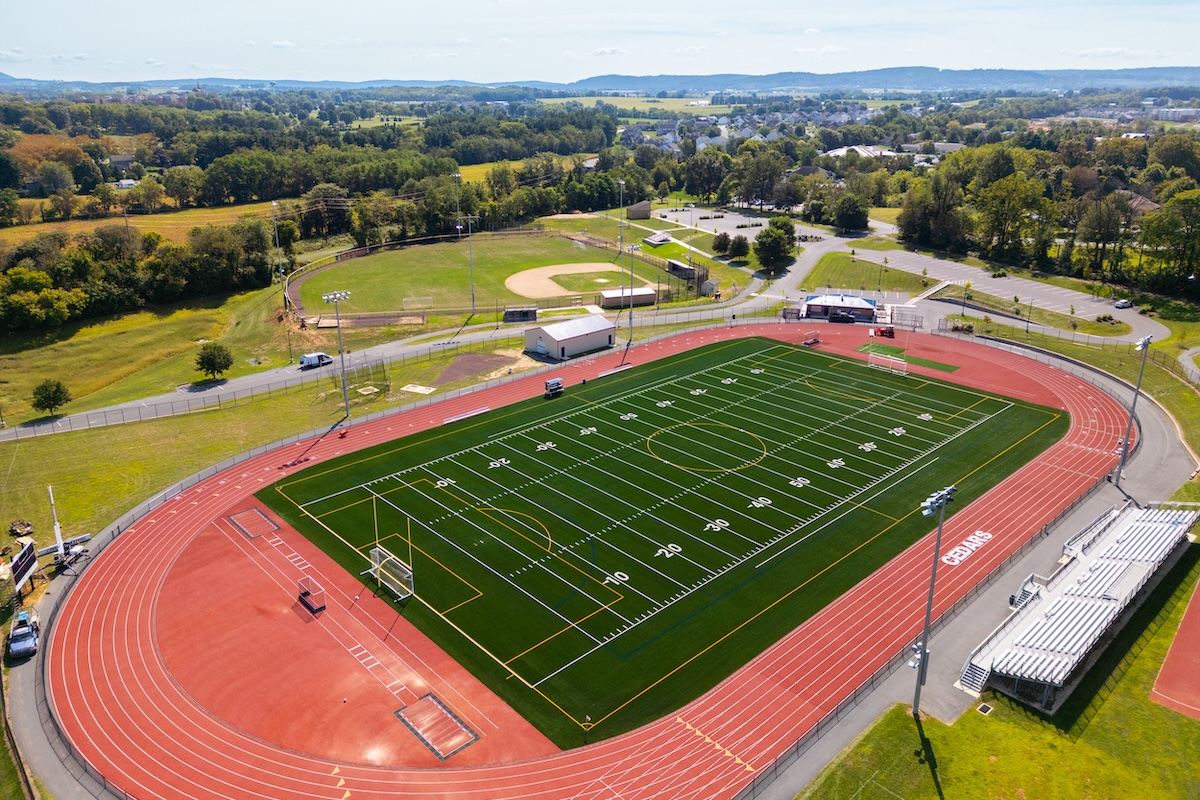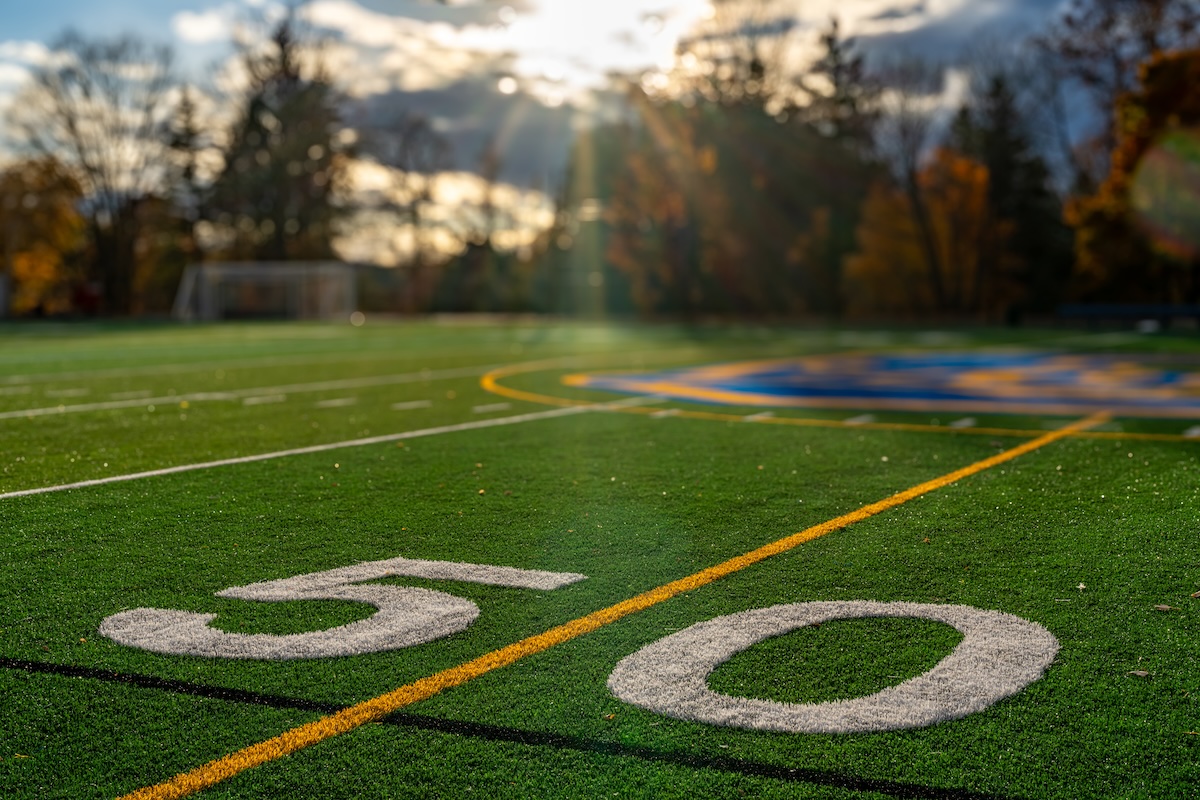Last Updated on November 4, 2025 by UDC Sports
Every school eventually reaches a stage where natural grass sports fields can no longer handle the volume of play demanded by expanding sports programs, physical education classes, and community events. Bare patches, puddled end zones, and repeated closures often prompt administrators to ask a difficult but practical question: should the district invest in artificial turf?
The answer depends on a balance of facts, not trends. Natural grass and synthetic turf each bring unique engineering requirements, safety factors, and financial implications. The right decision for one school can be entirely wrong for another, and the following sections break down every major factor that should guide the process.
Field Performance and Playability
Artificial turf’s primary advantage lies in availability. A single well-built synthetic field can handle approximately 3,000 hours of play annually, while a natural grass field of comparable size may safely support only 600 to 1,000 hours. That difference translates into entire seasons saved from cancellation.
Scheduling Flexibility
Natural grass fields must rest between heavy uses. Wet conditions can lead to ruts that require weeks of repair. Synthetic turf drains through the sub-base and can reopen within hours after rain. For schools sharing one multipurpose sports field among football, soccer, lacrosse, and marching band, this reliability often justifies the investment.
Surface Consistency
Grass changes texture daily with weather and mowing height. Artificial turf maintains a uniform surface that helps coaches plan consistent drills and reduces unpredictable footing. Regular maintenance is still required, but performance remains stable across different seasons.
Safety and Player Health
Safety concerns dominate every facilities meeting. The decision is never just about grass versus fiber; it revolves around impact absorption, surface hardness, and temperature.
Shock Absorption and Testing
Impact safety is measured by a Gmax test. Readings below 165 indicate a safe, cushioned field. Higher numbers mean compaction and a need for de-infill or maintenance. Schools that test annually and keep documented results protect both players and liability coverage.
Heat Management
Artificial turf absorbs and retains solar heat. Surface readings on summer days can exceed 150 degrees Fahrenheit, creating potential for burns and heat illness. Mitigation steps include light-colored infill, scheduled watering before events, and mandatory hydration breaks. Grass, by contrast, remains far cooler and may be safer for midday play in southern climates.
Environmental and Regulatory Considerations
Environmental compliance now influences nearly every field project. Both systems carry responsibilities that extend beyond play quality.
Microplastics and Infill Choices
Traditional crumb rubber infill can migrate through runoff. The European Union has already approved a restriction that bans polymeric infills beginning in 2031, and many U.S. manufacturers are adapting in advance. New alternatives use cork, coconut fiber, or coated sand to minimize particle loss and heat. These organic or mineral options require slightly more maintenance but reduce long-term environmental scrutiny.
PFAS and Chemical Transparency
Laboratory analyses have found trace PFAS chemicals in some turf backings and fibers. These substances likely originate from manufacturing processes rather than deliberate inclusion. Several vendors now supply PFAS-free verified materials and provide certification during bidding. Transparency on this topic can prevent community resistance later.
Health and Safety Research
Federal research programs led by the Environmental Protection Agency and the Centers for Disease Control have measured low exposure levels to crumb rubber during typical field use. While the data are incomplete, results suggest minimal risk when surfaces are cleaned and monitored regularly. Schools can show diligence by keeping sanitation records and communicating updates publicly.
Stormwater and Heat Island Effects
Synthetic turf drains efficiently through engineered layers but functions like an impervious surface within a watershed. Runoff temperatures rise more quickly than with natural grass, which can affect nearby vegetation and waterways. Designers offset this with vegetated buffer zones, infiltration trenches, or cooled drainage systems.
Operational Scheduling and Facility Usage
Artificial turf excels when space is limited. One field can host morning PE classes, afternoon practices, and evening games without downtime. This is especially valuable where community sports share facilities with the school district.
Natural grass fields are still favored for their cooling effect and softer play, yet require managed rotation. A combination model, one synthetic field surrounded by grass practice areas, offers both capacity and comfort.
Accessibility, Equity, and Compliance
Title IX compliance requires equal access to quality facilities across all sports and genders. Synthetic turf simplifies scheduling equality because one field can accommodate multiple programs with identical surface standards.
Accessibility compliance must also be considered. Wheelchair routes, bench zones, and sideline access points must meet ADA slope and material requirements. Both turf and grass systems can achieve compliance if designed correctly.
Maintenance and Quality Assurance
A surface’s long-term success depends on discipline, not material. Synthetic and natural systems each demand regular technical oversight.
For synthetic turf:
- Weekly grooming to lift fibers and distribute infill.
- Monthly decompaction of high-traffic zones.
- Annual Gmax and traction testing by certified technicians.
- Sanitization after heavy use or spills.
For natural grass:
- Aeration and topdressing multiple times per year.
- Regular overseeding and fertility adjustment.
- Drainage inspection following storms.
- Monitoring of thatch levels and soil compaction.
Documenting these routines builds a maintenance record that satisfies warranty conditions and reduces risk.
Environmental Mitigation Practices
When a district installs synthetic turf, mitigation steps demonstrate environmental responsibility:
- Curbs and trap mats at gates capture displaced infill.
- Filter baskets in drains prevent runoff contamination.
- Perimeter vegetation collects residual material.
- Organic or mineral infills limit plastic migration.
- End-of-life recycling agreements handle carpet removal safely.
These steps reduce environmental impact and help win community approval during public funding reviews.
When Natural Grass is the Better Fit
Natural grass remains ideal where land and expertise exist to maintain it. Sand-based or hybrid-reinforced fields drain quickly and support moderate traffic. Hybrids stitch synthetic fibers into living grass roots, providing a balance of durability and cooling comfort.
Grass fields also support environmental education. They foster pollinator habitats, reduce surface heat, and improve stormwater absorption. For schools with agricultural or environmental science programs, natural grass can double as an outdoor learning resource.
A Structured Decision Framework
A clear process converts debate into data. Districts can follow these checkpoints:
- Quantify yearly hours of field use.
- Assess local rainfall and soil drainage capacity.
- Evaluate maintenance staffing and expertise.
- Project 20-year costs, including replacement cycles.
- Review environmental and health compliance.
- Plan procurement with independent performance testing.
- Develop a written heat safety and hydration policy.
Following these steps ensures that the board’s final vote rests on measurable factors rather than assumptions.
Communication and Community Engagement
Parents and local residents are more likely to support a project when information is public. Sharing design drawings, maintenance schedules, and test results prevents speculation. Hosting open meetings where experts explain PFAS, infill materials, and cost comparisons helps everyone understand the reasoning behind the decision.
Long-Term Asset Management
Every sports field should be treated as a tracked capital asset. Maintain a log of serial numbers, warranty terms, and maintenance dates. Allocate a replacement reserve early, even in the first installation year. Consistent planning avoids financial shocks later and protects district credibility.
Making the Choice
No universal rule decides between grass vs artificial turf for school sports fields. Synthetic systems serve districts needing constant availability and multi-sport scheduling. Natural or hybrid fields serve those prioritizing cooler temperatures, environmental balance, and instructional opportunities. What matters most is whether the chosen system aligns with community values, climate, and financial endurance.
Building Smarter Fields with UDC Sports Construction
Athletic surfaces are part of the learning environment. They influence safety, performance, and pride in every game played. Choosing the correct system protects both students and budgets far into the future.
UDC Sports Construction specializes in both natural and synthetic athletic field design, construction, and consultation. Our engineering background, drainage expertise, and hands-on project management help schools make durable, cost-effective improvements. Contact us today to plan a field system that delivers dependable play and long-term value for your program.
Every school eventually reaches a stage where grass fields can no longer handle the volume of play demanded by expanding sports programs, physical education classes, and community events. Bare patches, puddled end zones, and repeated closures often prompt administrators to ask a difficult but practical question: should the district invest in artificial turf?
The answer depends on a balance of facts, not trends. Natural grass and synthetic turf each bring unique engineering requirements, safety factors, and financial implications. The right decision for one school can be entirely wrong for another, and the following sections break down every major factor that should guide the process.
Field Performance and Playability
Artificial turf’s primary advantage lies in availability. A single well-built synthetic field can handle approximately 3,000 hours of play annually, while a natural grass field of comparable size may safely support only 600 to 1,000 hours. That difference translates into entire seasons saved from cancellation.
Scheduling Flexibility
Natural grass fields must rest between heavy uses. Wet conditions can lead to ruts that require weeks of repair. Synthetic turf drains through the sub-base and can reopen within hours after rain. For schools sharing one multipurpose stadium among football, soccer, lacrosse, and marching band, this reliability often justifies the investment.
Surface Consistency
Grass changes texture daily with weather and mowing height. Artificial turf maintains a uniform surface that helps coaches plan consistent drills and reduces unpredictable footing. Regular maintenance is still required, but performance remains stable across different seasons.
Safety and Player Health
Safety concerns dominate every facilities meeting. The decision is never just about grass versus fiber; it revolves around impact absorption, surface hardness, and temperature.
Shock Absorption and Testing
Impact safety is measured by a Gmax test. Readings below 165 indicate a safe, cushioned field. Higher numbers mean compaction and a need for de-infill or maintenance. Schools that test annually and keep documented results protect both players and liability coverage.
Heat Management
Artificial turf absorbs and retains solar heat. Surface readings on summer days can exceed 150 degrees Fahrenheit, creating potential for burns and heat illness. Mitigation steps include light-colored infill, scheduled watering before events, and mandatory hydration breaks. Grass, by contrast, remains far cooler and may be safer for midday play in southern climates.
Financial Planning Over Time
A realistic budget review requires both construction and life-cycle accounting. Synthetic and natural systems trade costs between installation, maintenance, and longevity.
Installation and Replacement
- Synthetic turf construction: typically ranges from 1.1 to 1.4 million dollars for a full high school field.
- Carpet replacement: required every 8 to 12 years, averaging 750,000 to 850,000 dollars.
- Shock pad lifespan: often 20 years or longer, reused for multiple carpet cycles.
- Natural grass construction: 600,000 to 1 million dollars when sand-based with drainage and irrigation.
Maintenance Budgets
- Synthetic turf: 12,000 to 30,000 dollars per year for brushing, decompaction, sanitation, and testing.
- Natural grass: 20,000 to 55,000 dollars per year for aeration, fertilization, overseeding, and irrigation.
When measured per playable hour, synthetic systems tend to lower total cost for districts that host constant use, while grass remains economical where multiple fields share traffic.
Environmental and Regulatory Considerations
Environmental compliance now influences nearly every field project. Both systems carry responsibilities that extend beyond play quality.
Microplastics and Infill Choices
Traditional crumb rubber infill can migrate through runoff. The European Union has already approved a restriction that bans polymeric infills beginning in 2031, and many U.S. manufacturers are adapting in advance. New alternatives use cork, coconut fiber, or coated sand to minimize particle loss and heat. These organic or mineral options require slightly more maintenance but reduce long-term environmental scrutiny.
PFAS and Chemical Transparency
Laboratory analyses have found trace PFAS chemicals in some turf backings and fibers. These substances likely originate from manufacturing processes rather than deliberate inclusion. Several vendors now supply PFAS-free verified materials and provide certification during bidding. Transparency on this topic can prevent community resistance later.
Health and Safety Research
Federal research programs led by the Environmental Protection Agency and the Centers for Disease Control have measured low exposure levels to crumb rubber during typical field use. While the data are incomplete, results suggest minimal risk when surfaces are cleaned and monitored regularly. Schools can show diligence by keeping sanitation records and communicating updates publicly.
Stormwater and Heat Island Effects
Synthetic turf drains efficiently through engineered layers but functions like an impervious surface within a watershed. Runoff temperatures rise more quickly than with natural grass, which can affect nearby vegetation and waterways. Designers offset this with vegetated buffer zones, infiltration trenches, or cooled drainage systems.
Operational Scheduling and Facility Usage
Artificial turf excels when space is limited. One field can host morning PE classes, afternoon practices, and evening games without downtime. This is especially valuable where community sports share facilities with the school district.
Natural grass fields are still favored for their cooling effect and softer play, yet require managed rotation. A combination model, one synthetic field surrounded by grass practice areas, offers both capacity and comfort.
Accessibility, Equity, and Compliance
Title IX compliance requires equal access to quality facilities across all sports and genders. Synthetic turf simplifies scheduling equality because one field can accommodate multiple programs with identical surface standards.
Accessibility compliance must also be considered. Wheelchair routes, bench zones, and sideline access points must meet ADA slope and material requirements. Both turf and grass systems can achieve compliance if designed correctly.
Maintenance and Quality Assurance
A surface’s long-term success depends on discipline, not material. Synthetic and natural systems each demand regular technical oversight.
For synthetic turf:
- Weekly grooming to lift fibers and distribute infill.
- Monthly decompaction of high-traffic zones.
- Annual Gmax and traction testing by certified technicians.
- Sanitization after heavy use or spills.
For natural grass:
- Aeration and topdressing multiple times per year.
- Regular overseeding and fertility adjustment.
- Drainage inspection following storms.
- Monitoring of thatch levels and soil compaction.
Documenting these routines builds a maintenance record that satisfies warranty conditions and reduces risk.
Environmental Mitigation Practices
When a district installs synthetic turf, mitigation steps demonstrate environmental responsibility:
- Curbs and trap mats at gates capture displaced infill.
- Filter baskets in drains prevent runoff contamination.
- Perimeter vegetation collects residual material.
- Organic or mineral infills limit plastic migration.
- End-of-life recycling agreements handle carpet removal safely.
These steps reduce environmental impact and help win community approval during public funding reviews.
When Natural Grass is the Better Fit
Natural grass remains ideal where land and expertise exist to maintain it. Sand-based or hybrid-reinforced fields drain quickly and support moderate traffic. Hybrids stitch synthetic fibers into living grass roots, providing a balance of durability and cooling comfort.
Grass fields also support environmental education. They foster pollinator habitats, reduce surface heat, and improve stormwater absorption. For schools with agricultural or environmental science programs, natural grass can double as an outdoor learning resource.
A Structured Decision Framework
A clear process converts debate into data. Districts can follow these checkpoints:
- Quantify yearly hours of field use.
- Assess local rainfall and soil drainage capacity.
- Evaluate maintenance staffing and expertise.
- Project 20-year costs, including replacement cycles.
- Review environmental and health compliance.
- Plan procurement with independent performance testing.
- Develop a written heat safety and hydration policy.
Following these steps ensures that the board’s final vote rests on measurable factors rather than assumptions.
Communication and Community Engagement
Parents and local residents are more likely to support a project when information is public. Sharing design drawings, maintenance schedules, and test results prevents speculation. Hosting open meetings where experts explain PFAS, infill materials, and cost comparisons helps everyone understand the reasoning behind the decision.
Long-Term Asset Management
Every field should be treated as a tracked capital asset. Maintain a log of serial numbers, warranty terms, and maintenance dates. Allocate a replacement reserve early, even in the first installation year. Consistent planning avoids financial shocks later and protects district credibility.
Making the Choice
No universal rule decides between turf and grass. Synthetic systems serve districts needing constant availability and multi-sport scheduling. Natural or hybrid fields serve those prioritizing cooler temperatures, environmental balance, and instructional opportunities. What matters most is whether the chosen system aligns with community values, climate, and financial endurance.
Building Smarter Fields with UDC Sports Construction
Athletic surfaces are part of the learning environment. They influence safety, performance, and pride in every game played. Choosing the correct system protects both students and budgets far into the future.
UDC Sports Construction specializes in both natural and synthetic athletic field design, construction, and consultation. Our engineering background, drainage expertise, and hands-on project management help schools make durable, cost-effective improvements. Contact us today to plan a field system that delivers dependable play and long-term value for your program.







